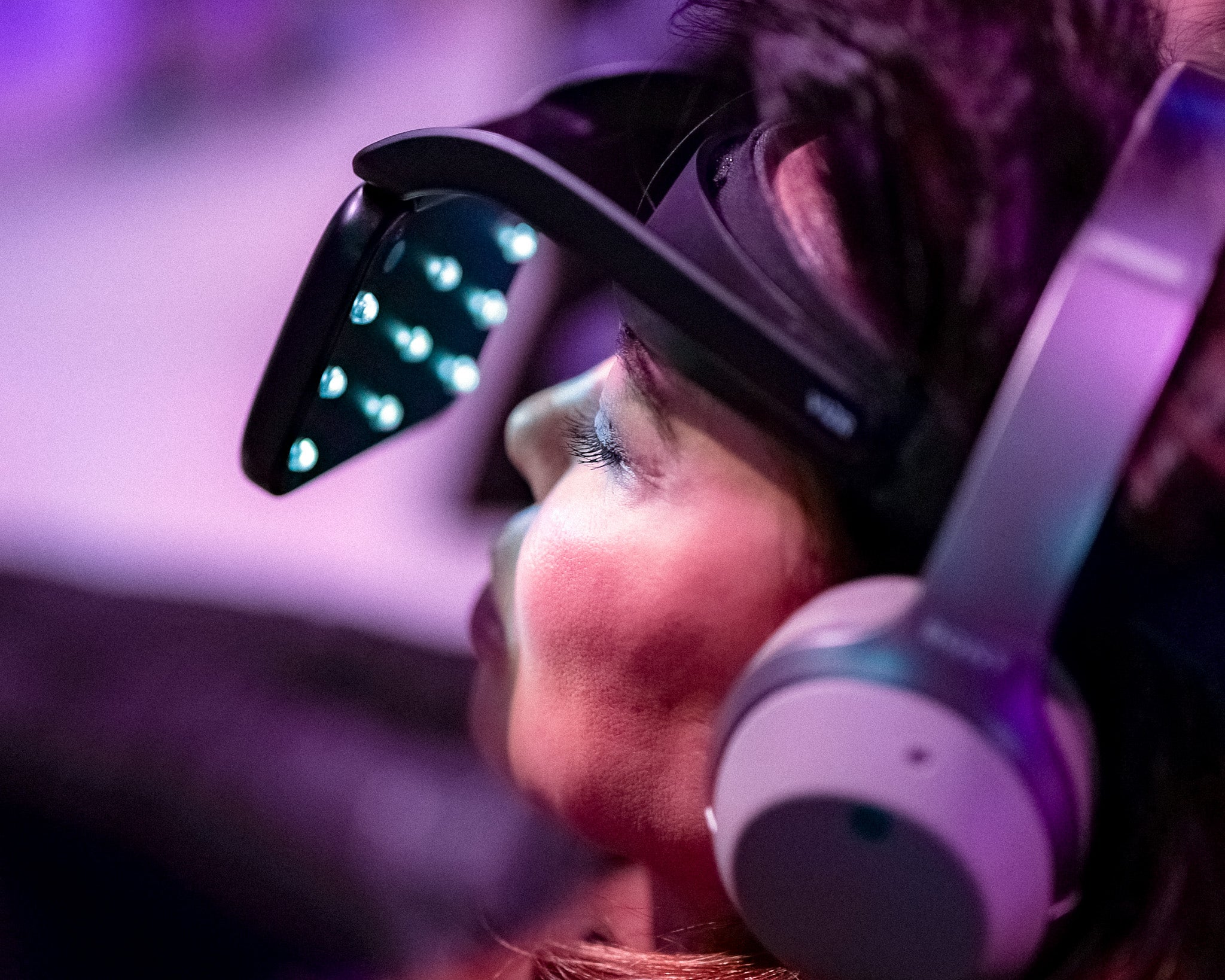
FAQ's
1. What Is neuroVIZR and what does it do?
neuroVIZR is a transformative light and sound device crafted to facilitate profound personal growth and mental health enhancement.
By enveloping you in dynamic artful stimuli, neuroVIZR sessions are
meticulously designed to elevate cognitive functions and instigate a deep
inward journey aimed at bolstering mental wellness. This innovative device
employs a synergistic combination of sensory inputs to create a fully immersive experience, designed to catalyze change and foster an enriched mental state.
Note: The device provides wellness-related brain exercise and learning, NOT
treatments or therapies.
2. Is it safe?
neuroVIZR is engineered with safety as a paramount concern and is harmless for the overwhelming majority of individuals. It is prudent for new users to perform light sensitivity assessments to gauge any unique responses. Although neuroVIZR is generally safe, individuals diagnosed with epilepsy or those susceptible to light-induced seizures should abstain from its use. For those with heightened sensitivity to light or visual stimuli,a cautious approach is advised.
3. How do we differ from other products?
Unlike conventional devices that employ "Guided Imagery" or similar Top-Down approaches, neuroVIZR utilizes a Bottom-Up strategy through immediate Light/Sound stimulation, which differentiates its methodology in brain engagement. neuroVIZR is distinguished by its ability to modulate the circadian rhythm to improve sleep patterns and induce a state of tranquility, offering a multifaceted approach to cognitive engagement.
4. How Long and How Often should I use neuroVIZR?
The duration of each neuroVIZR session is meticulously set to 11 minutes to capture the peak period of brain focus without causing strain. For substantial and tangible results, a regimen of 3 to 5 sessions weekly is recommended. It is important to note that lifestyle factors outside of these sessions can significantly influence the efficacy, hence maintaining positive cognitive activities throughout the week is essential for enhanced
progress.
5. Can I do a few sessions in a row?
While back-to-back sessions are possible, it's vital to heed your own response to sensory stimulation. The true benefits of neuroVIZR accrue during the 'Brain Time' integration phase that follows light and sound exposure. You may concatenate sessions, with optional meditative breathing interludes, always being attentive to your personal threshold for stimulus.
6. Are there any routines available that I can adhereto?
neuroVIZR provides a spectrum of recommended routines designed to maximize the device's impact. Users are encouraged to either follow these or to curate their own sequence of sessions. Skipping sessions does not lead to detrimental effects, and users are encouraged to explore various sessions to identify those that resonate best with their individual needs.
7. What About The Session Itself?
During a session, users can customize light and sound levels for optimal comfort. The session demands brief moments of increased cognitive effort, which are essential for fostering positive neuroplasticity. Selecting a comfortable yet attentive posture is advised, as overly relaxed states may diminish the capacity for focused engagement.
8. Which Session should I choose?
neuroVIZR boasts an array of Themes, each with different neuroplastic demands, tailored to various user levels and goals. For novices, starting with the highest-rated theme is advisable. Users should either stick with one particular sequence to maintain consistency or experiment with a few themes that align with their objectives.
9. What kind of effects should I expect?
neuroVIZR is designed to facilitate both immediate mood enhancements and gradual cognitive development. The device doesn't impose change but rather encourages the brain into flexible "probability states" conducive to learning and adaptation. While results can vary among individuals, consistent use is typically linked with beneficial changes.
10. When can I see the 1st results?
The timeframe for observing results from neuroVIZR is Certainly! The timeframe for observing results from neuroVIZR sessions is highly individualistic and can vary widely depending on personal differences, life circumstances, and past experiences. Some users may notice changes relatively quickly, while for others it might take longer. It is important to approach the sessions with patience and an open mind, allowing for self-discovery and experimentation to find the approach that yields personal
best results.
11. I don’t see any colors, just white and grey/black?
The perception of colors during neuroVIZR sessions can differ from person to person, and like any skill, may improve with practice.
The brain's ability to perceive and interpret sensory information can be honed over time through consistent use of the device, much like enhancing physical fitness through exercise. Persisting with regular sessions can gradually enhance the brain's perceptual capabilities and lead to a richer sensory experience.
12. Is neuroVIZR safe for me?
For most people, neuroVIZR is considered safe. Precautionary measures, such as light sensitivity tests, are suggested for new users to ensure a comfortable experience. Those with a predisposition to seizures or who are particularly sensitive to visual stimuli may need to adjustthe device's settings or may experience mild discomfort temporarily. Tailoringthe light and sound levels can help mitigate any such effects.
Pregnant women should consult their medical practitioner before using this device.
13. Can a child use neuroVIZR?
neuroVIZR is specifically tailored for adult users, with a recommended age of 18 years and above. The developing brains of individuals under 18 are more susceptible to influence, and therefore the use of neuroVIZR on this age group is not advised without professional guidance.
14. Can I use neuroVIZR if I am diagnosed with epilepsy or any seizure disorder, suffering from acute photo-sensitivity, acute eye disorder, acute vertigo, or acute psychosis?
Individuals with these conditions should not use neuroVIZR due to the risk of exacerbating symptoms or triggering adverse reactions. It is critical to consult with a healthcare professional before using neuroVIZR or similar devices if you have any of the aforementioned conditions.
15. I was never diagnosed with one of the previous conditions, can I use neuroVIZR?
While the incidence of photosensitive seizures in individuals with no prior history is rare, there is still a possibility of such an event occurring. Users must exercise discretion and assume full responsibility when deciding to use neuroVIZR
16. Is it dangerous to open the eyes during thesessions? Are LED lights harmful for my eyes?
Directly viewing the flashing LEDs of neuroVIZR with open eyes is not recommended. Prolonged exposure to intense light, particularly if it is flashing, can lead to discomfort or irritation. It is essential to adhere to the guidelines provided to ensure a safe and comfortable experience.
17. I am suffering from headaches, dizziness, and fatigue after a session, is this normal?
Transient symptoms such as headaches, dizziness, and fatigue can occur as the body adjusts to the sensory input from neuroVIZR. Reducing the intensity of light and sound and using the device when well-rested can help alleviate these symptoms. However, if these symptoms persist, it may be prudent to consult with a healthcare provider.
18. Can I use neuroVIZR if I have drunk alcohol or had drugs?
The use of neuroVIZR under the influence of alcohol or drugs is not recommended as these substances can alter the perception and effect of the session, potentially leading to an adverse experience.
19. Can the neuroVIZR damage my brain?
There is no current evidence to suggest that the type of signals used by neuroVIZR, which have a history of over 40 years of use, can cause brain damage. As with any device affecting sensory perception, it is essential to follow usage instructions carefully.
20. Can I use the neuroVIZR with other music?
While it is technically possible to use neuroVIZR with other music, doing so may diminish the effectiveness of the embedded brain signals that are specifically designed to work in concert with the light patterns. For the most beneficial experience, it is recommended to use the proprietary soundscapes created for neuroVIZR.
21. What level of Light Intensity should I use?
The neuroVIZR device offers a spectrum of light intensity levels from 1 to 10, with 5 being the median suitable for the average user. The selection of intensity should be personalized, taking into account individual sensitivity, the ambient lighting of the environment, and the desired comfort level. Users are encouraged to start at a lower intensity and gradually find the level that provides the most comfortable and effective experience.
22. I have another question
Please use the Contact Form
